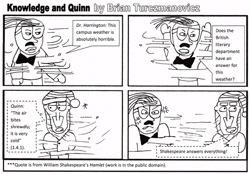Usually when readers open up a comic book, they will notice word bubbles or captions that contain character dialogue or thoughts. Yet, there are points when writers and artists decided to take risks and tell stories that rely on visual storytelling more than words.
Known as silent issues, these particular tales are somewhat uncommon, but nevertheless, interesting to read when they are published. So, with the silent movie The Artist being a big winner at the Academy Awards, why not take a look back at comics whose pictures spoke louder than words?
To begin, one of the more memorable silent issues was “G.I. Joe” #21 from Marvel Comics, written by Larry Hama, who also did the breakdown art, and finishings art by Steve Leialoha.
The story titled, “Silent Interlude,” was about the silent ninja and soldier, Snake Eyes, going on a mission to rescue fellow G.I. Joe member, Scarlett. Telling the story silently with Snake Eyes as the lead seemed appropiate since the character never spoke to anyone and let his actions talk for him.
The issue was also notable for introducing Snake Eyes’ rival, Storm Shadow, into the G.I. Joe cast.
According to joeguide.com (via Comics Interview #37-38), Hama explained what his real intention behind writing and illustrating “Silent Interlude” was. He said, “I wanted to see if I could do a story that was a real, complete story – beginning, middle, end, conflict, characterization, action, solid resolution – without balloons or captions or sound effects. I tried to do it again, as a matter of fact, with the Joe Yearbook #3 story.”
Hama went on to create one more silent issue for Marvel with “G.I. Joe” #85 (it featured Storm Shadow) and one for IDW after they took over the G.I. Joe property with “G.I. Joe Origins” #19 (another tale that focused on the elusive Snake Eyes). While talking to ifanboy.com at the 2010 San Diego Comic-con, IDW Senior Editor Andy Schmidt described the excitement of telling another silent Joe story. “One of the first things I wanted to do as a G.I. Joe editor was revisit the silent issue. It’s just too fun not to do again…This time we brought on the incredibly talented and dynamic artist Joe Benitez to punch it up and hit it out of the park!” Schmidt said.
While “G.I. Joe” #21 was iconic for telling a silent issue, Marvel would return to this format starting late 2001 and continuing in 2002, where different Marvel series were wordless. The comics were united under the banner known as “‘Nuff Said,” and included issues such as: “Amazing Spider-Man” #39, “Captain America” #50, and “Uncanny X-Men” #401. These issues were also collected together in the trade paperback, “‘Nuff Said.”
A synopsis on marvel.com for the trade paperback described the basis for the comic book venture. It read, “Marvel President Bill Jemas and Editor-in-Chief Joe Quesada hatched a test for the Mighty Marvel Maestros: Since you’re the best artists and writers in the biz, we challenge you to tell a story using visuals only.”
“Amazing Spider-Man” Volume 2 #39 has continued to stand out today for two aspects. 1) A memorable silent cover with Spider-Man covering a crook’s mask and a “‘Nuff Said” slapped on it, and 2) the way the then-series writer (J. Michael Straczynski) and artist (John Romita, Jr.) told their Spidey tale just as effectively as any other issue filled with word bubbles and thought captions.
Yet, “Amazing Spider-Man” #39 wasn’t the only book that had readers excited by this event. In a mania.com review by Tony Whitt for “Captain America” #50, he wrote, “The ‘Nuff Said’ story this time is actually not at all bad, and it’s probably because Dan Jurgens provides the pencilwork as well as the script, aided only by inker Bob Layton. I’ve often said that these stories only work if the writer and artist(s) are in sync on the story, and what better way to ensure that synchronicity than by drawing part of your own script yourself?”
Marvel continued to tell one more silent issue with stories featured in their 9/11 memorial graphic novel, “A Moment of Silence.”
Although DC Comics doesn’t have any silent issues I could recall or find, that doesn’t mean they haven’t stayed in the spirit of Snake Eyes and presented quiet yet skillful fighters.
One character that easily fits into this category is the third Batgirl, Cassandra Cain, who spoke through body language rather than words.
When writer Andersen Gabyrich took over the “Batgirl” monthly series, she explained to comicbookresources.com that while Cassandra doesn’t speak to others, she still has a way of communicating. “I think that the ability of deduction and being able to put together pieces is very much a part of what her language is. She could walk into a room and automatically know what’s different; that sense that something doesn’t seem right. She’s not a psychic and can be easily fooled, but as far as her initial response to things, her physical space is what she knows,” Gabyrich said.
Other silent DC characters have included the Legion of Super-Villains leader, Tarik the Mute and Jericho from “Teen Titans.” (Marvel has also had their share of brooding, silent types such as Black Bolt, king of the Inhumans and the earthly hulking Man-Thing.)
While comics have always been a visual medium, these silent issues took their description to a new level where the story was completely dependent on the art. They demonstrated how this medium is always experimenting with new ways to present their adventures and stories. Overall, these series and characters bring new meaning to “Shhh! I’m reading.”



